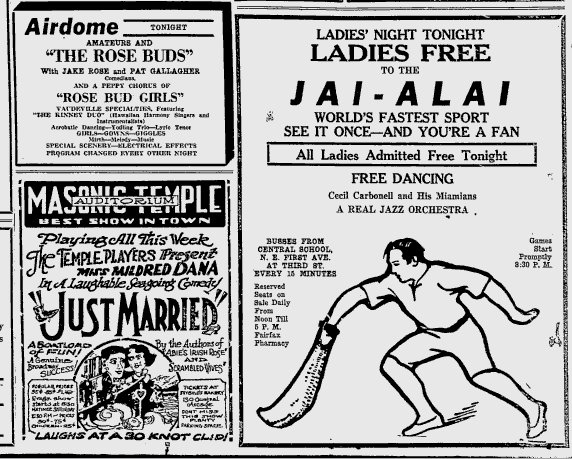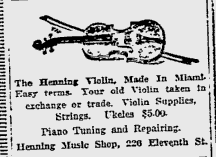SFMA History: Beginnings Through 1920's
PRE-SFMA History
The American Federation of Musicians was formed in 1896, the same year that Miami was incorporated. The first Locals of the AFM were located in, among other places, St. Louis, Cleveland, Milwaukee, and Sacramento. In 1910, the year that the Miami Herald began publishing, 1681 people lived in Miami. Fort Lauderdale was incorporated in 1911, and a year later, Henry Flagler's East Coast Railroad opened to Key West.
Chartering of Local 655
South Florida  Musicians Association was chartered on September 24, 1913 as the Musicians Protective Union Local 655. Charter members of the Local included Chas. Stanage, Elmer Hornberger, J.C. Rogers Jr., Raymond O'Brian, E.G. Law, E.M. Jeffords, Floyd Chaille, and Henry Hall. Other local events in 1913 included the opening of the Lyric Theater in Stuart and the opening of the Collins Bridge and early development of Miami Beach. Other notable events from 1913 included the premiere of Stravinsky's Rite of Spring, the ratification of the 16th Amendment creating a national income tax, and the creation of the Federal Reserve System.
Musicians Association was chartered on September 24, 1913 as the Musicians Protective Union Local 655. Charter members of the Local included Chas. Stanage, Elmer Hornberger, J.C. Rogers Jr., Raymond O'Brian, E.G. Law, E.M. Jeffords, Floyd Chaille, and Henry Hall. Other local events in 1913 included the opening of the Lyric Theater in Stuart and the opening of the Collins Bridge and early development of Miami Beach. Other notable events from 1913 included the premiere of Stravinsky's Rite of Spring, the ratification of the 16th Amendment creating a national income tax, and the creation of the Federal Reserve System.
1920's
By the 1920 census, 29,549 people lived in Miami. The 1920's saw the opening of the Venetian Pool (1924), the founding of the University of Miami (1925), the opening of the Biltmore and the Breakers (1926), the dedication of Port Everglades (1928), and the opening of the Tamiami Trail (1928). 1926 also saw the Great Miami Hurricane, a category 4 storm that devastated Miami.
Early Musical Life in Miami
 The real estate industry was one sponsor of concerts in the 1920's. They would hire big bands and use popular music to help sell land in south Florida. The Venetian Pool was one early venue for concerts. The pool would be drained and orchestras would perform on the pool floor. Both Miami Grand Opera and Paul Whiteman and his band performed in the pool. The Miami Jai-Alai and the Miami Beach Casino also hosted concerts, and artists included the Schuester Entertainment Family from New York and the local jazz orchestra, Cecil Carbonell and his Miamians.
The real estate industry was one sponsor of concerts in the 1920's. They would hire big bands and use popular music to help sell land in south Florida. The Venetian Pool was one early venue for concerts. The pool would be drained and orchestras would perform on the pool floor. Both Miami Grand Opera and Paul Whiteman and his band performed in the pool. The Miami Jai-Alai and the Miami Beach Casino also hosted concerts, and artists included the Schuester Entertainment Family from New York and the local jazz orchestra, Cecil Carbonell and his Miamians.
Miami was also home to a violin maker from 1914 to 1920. Gustav Henning, a Swedish native, immigrated to America and established himself as a violin maker in Boston, after having worked for piano makers Chickering and Sons. He later moved to Miami, then to Denver, and eventually settled in Seattle Washington. One of the violins made by Henning in Miami in 1919 is on display at the Smithsonian's National Museum of American History.
Write reply
Comments must be approved before being published.





